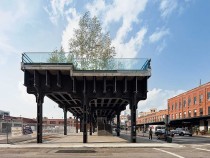
© Iwan Baan
Extending over 2.5 km, the High Line winds its way through the West Side of Manhattan. When the elevated railway was built in the 1930s, freight trains were able in part to pull up directly at the factories and warehouses of the former commercial areas of the city: the meatpacking district, West Chelsea and Hell’s Kitchen/Clinton. In the meantime, many of these neighbourhoods have been transformed and house trendy galleries, restaurants and boutiques, as well as containing expensive offices and housing. The railway strip itself has been disused since 1980 and was threatened with demolition. Thanks to the initiative of Friends of the High Line, it has now been converted into a public park and has since become one of the main attractions of New York City. Divided into three constructional sections, the first was opened in 2009, and the second, longer section in May 2011. Inspired by the aesthetics of the cast-iron load-bearing structure and by the tracks, which had become overgrown, the concept for the park foresaw a series of architectural and landscape elements along the railway strip. This allowed the creation of locations with many different qualities, from sunny paved areas and beds of grass with flowers to shady groups of trees; from quiet retreats to meeting places and viewing points. The pavings to the pathways consist largely of narrow precast-concrete planks laid parallel to each other. The tapering ends of these are feathered in and out of the flower beds and interlock with the relaid railway tracks, so that a flowing transition is created between pavings and plantings. This is a recurring motif of the park.









